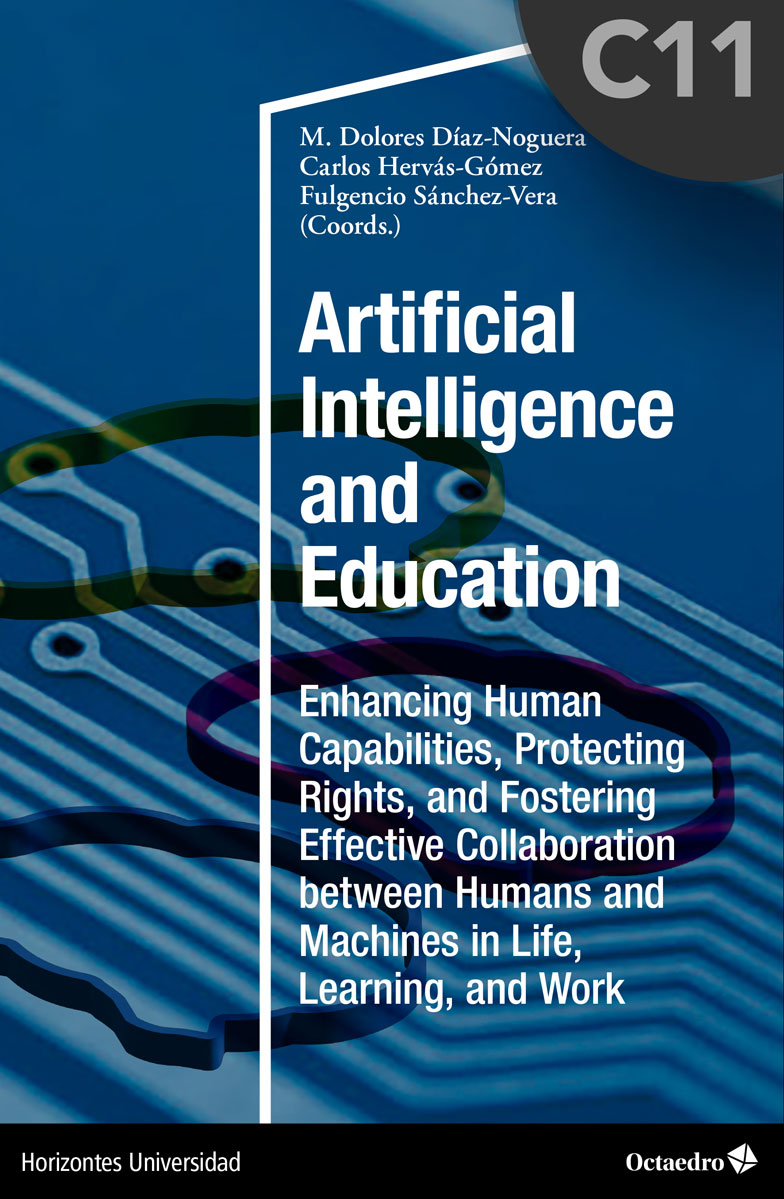FICHA TÉCNICA
Fecha de publicación:
06/11/2024
Doi del capítulo:
Título del libro: Artificial Intelligence and Education
URL del libro:
ISBN del libro: 9788410282452
DOI del libro:
Abstract
This work investigates how historical simulations integrated with artificial intelligence affect university students’ emotional responses. With the increasing adoption of digital technologies in education, particularly post-COVID-19, this study utilizes a quasi-experimental design and the Positive and Negative Affect Schedule (PANAS) to measure specific emotions during simulations. The results reveal significant variations in students’ emotions, highlighting calm and empathy as predominant responses, although anxiety and distress are reported in different simulation phases. Implementing ChatGPT showed a significant impact on pedagogical interest and the perception of AI in education, suggesting that these technologies can be valuable tools to enrich students’ educational and emotional experiences. The study advocates for a thoughtful and ethical integration of AI in teaching, emphasizing the need for teacher training modules that prepare educators for an effective and conscious use of emerging technologies.
Palabras clave
Autores
PhD Pablo Rosser
Universidad Internacional de La Rioja, Spain
pablo.rosser@unir.net
https://orcid.org/0000-0002-9802-7169
PhD Seila Soler
Universidad Isabel I, Spain
seilaaixa.soler@ui1.es
https://orcid.org/0009-0001-9125-3382
Cómo citar
Rosser, P., Soler, S. (2024). Emotions in Digital Learning: Assessing the Emotional and Pedagogical Impact of Historical Simulations through ChatGPT in University Classrooms. In Díaz-Noguera, M. D., Hervás-Gómez, C., Sánchez-Vera, F. (Coords.), Artificial Intelligence and Education (pp. 175-188). Octaedro. https://doi.org/10.36006/09643-1-11
Referencias bibliográficas
«Bai, S. (2023). The impact of gamification teaching methods on elementary students’ learning interest: A case study based on history class. Journal of Education, Humanities and Social Sciences, 22, 460-466. https://doi.org/10.54097/ehss.v22i.12504
Burzić, A., George, L., Mahmood, H., Smith, P., Tan, H. X., & Smith, D. P. (2021). P1 The adoption of digital technology in respiratory education in response to the covid-19 global pandemic. Thorax, 76(Suppl 1), A85-A85. https://doi.org/10.1136/thorax-2020-BTSabstracts.146
Candel, E. C., de-la-Peña, C., & Yuste, B. C. (2023). Pre-service teachers’ perception of active learning methodologies in history: Flipped classroom and gamification in an e-learning environment. Education and Information Technologies. https://doi.org/10.1007/s10639-023-11924-0
Catania, F., Di Nardo, N., Garzotto, F., & Occhiuto, D. (2019). Emoty: An Emotionally Sensitive Conversational Agent for People with Neurodevelopmental Disorders. http://hdl.handle.net/10125/59641
Chaudhry, I. S., Sarwary, S. A. M., El Refae, G. A., & Chabchoub, H. (2023). Time to revisit existing student’s performance evaluation approach in higher education sector in a new era of ChatGPT. A case study. Cogent Education, 10(1), 2210461. https://doi.org/10.1080/2331186X.2023.2210461
Drozdikova-Zaripova, A. R., & Sabirova, E. G. (2020). Usage of digital educational resources in teaching students with application of “flipped classroom” technology. Contemporary Educational Technology, 12(2), ep278. https://doi.org/10.30935/cedtech/8582
Gülen, S. (2018). Determination the effect of STEM integrated argumentation based science learning approach in solving daily life problems. World Journal on Educational Technology Current Issues, 10(4), 266-285. https://doi.org/10.18844/wjet.v10i4.4087
Karakose, T. (2023). The utility of ChatGPT in educational research potential opportunities and pitfalls. Educational Process: International Journal. https://edupij.com/index/arsiv/58/296/the-utility-of-chatgpt-in-educational-researchpotential-opportunities-and-pitfalls
Koong Lin, H.-C. (2022). Employing AI chatbot-based tutoring systems and STEAM 6e scaffold to implement cooperative learning of maker education. Impact, 5, 14-16. https://doi.org/10.21820/23987073.2022.5.14
Muniandy, T., Sharif, S., & Mariappan, M. (2022). The effect of robotics program on students attitude towards science. Malaysian Journal of Social Sciences and Humanities (MJSSH), 7(4), e001422–e001422. https://doi.org/10.47405/mjssh.v7i4.1422
Reyes-Mercado, P., Barajas-Portas, K., Kasuma, J., Almonacid-Duran, M., & Alfredo, Z.-A. G. (2022). Adoption of digital learning environments during the COVID-19 pandemic: Merging technology readiness index and UTAUT model. Journal of International Education in Business, 16(1), 91-114. https://doi.org/10.1108/JIEB-10-2021-0097
Rosser, P., & Soler, S. (2023). Resonancia emocional en estudiantes universitarios: un análisis del impacto de metodologías activas y pedagogía crítica en el espectro emocional del aprendizaje. In M. J. S. Villalba, M. J. A. del Olmo, F. J. F. Cerero, & M. M. Rueda (Eds.). Desafíos educativos a través de la interdisciplinariedad en la investigación y la innovación (pp. 105-113).
Rosser, P., & Soler, S. (2024). La aplicación de la teoría de la respuesta del lector y la educación pluralista en la didáctica de la historia de la Revolución industrial: un enfoque hermenéutico educativo a partir de IA y ChatGPT. In Propuestas educativas multidisciplinares en el marco de los Objetivos del Desarrollo Sostenible (ODS) y la Agenda 2030. Egregius.
Saavedra Bautista, C. E., & Valencia, J. A. P. (2014). Una mirada a los estilos de aprendizaje de los estudiantes de la UPTC desde la noción de nativo digital. Revista Academia y Virtualidad, 7(2), 41-52. https://doi.org/10.18359/ravi.317
Şahin, F., & Şahin, Y. L. (2022). Drivers of technology adoption during the COVID-19 pandemic: The motivational role of psychological needs and emotions for pre-service teachers. Social Psychology of Education: An International Journal, 25(2-3), 567-592. https://doi.org/10.1007/s11218-022-09702-w
Shavab, O. A. K., Yulifar, L., Supriatna, N., & Mulyana, A. (2021). Gamification in history learning: A literature review. Proceedings of the 6th International Conference on Education & Social Sciences (ICESS 2021), Semarang, Indonesia. https://doi.org/10.2991/assehr.k.210918.047
Soler, S., & Rosser, P. (2023). Empatizar con los conflictos bélicos para trabajar el ODS 16. Creación de una situación de aprendizaje a partir de la simulación urbana. In Hacia una Educación con basada en las evidencias de la investigación y el desarrollo sostenible. Dykinson.
Soler, S., & Rosser, P. (2024). Desafiando los límites del aprendizaje histórico: una propuesta educativa innovadora basada en la pedagogía crítica, ia y chatgpt para comprender la Guerra Civil Española, la dictadura franquista y la Transición democrática. In Las ciencias sociales, las humanidades y sus expresiones artísticas y culturales: una tríada indisoluble desde un enfoque educativo. Dykinson.
Sun, Q., & Zhu, Y. (2022). Teaching analysis for visual communication design with the perspective of digital technology. Computational and Mathematical Methods in Medicine, 2411811. https://doi.org/10.1155/2022/2411811
Watson, D., Clark, L. A., & Carey, G. (1988). Positive and negative affectivity and their relation to anxiety and depressive disorders. Journal of Abnormal Psychology, 97(3), 346-353. https://doi.org/10.1037//0021-843x.97.3.346
Zhu, A. (2023). Navigating the digital shift: the impact of educational technology on pedagogy and student engagement. Journal of Education and Educational Research, 6(6), 11-14. https://doi.org/10.54097/jeer.v6i1.14131»
